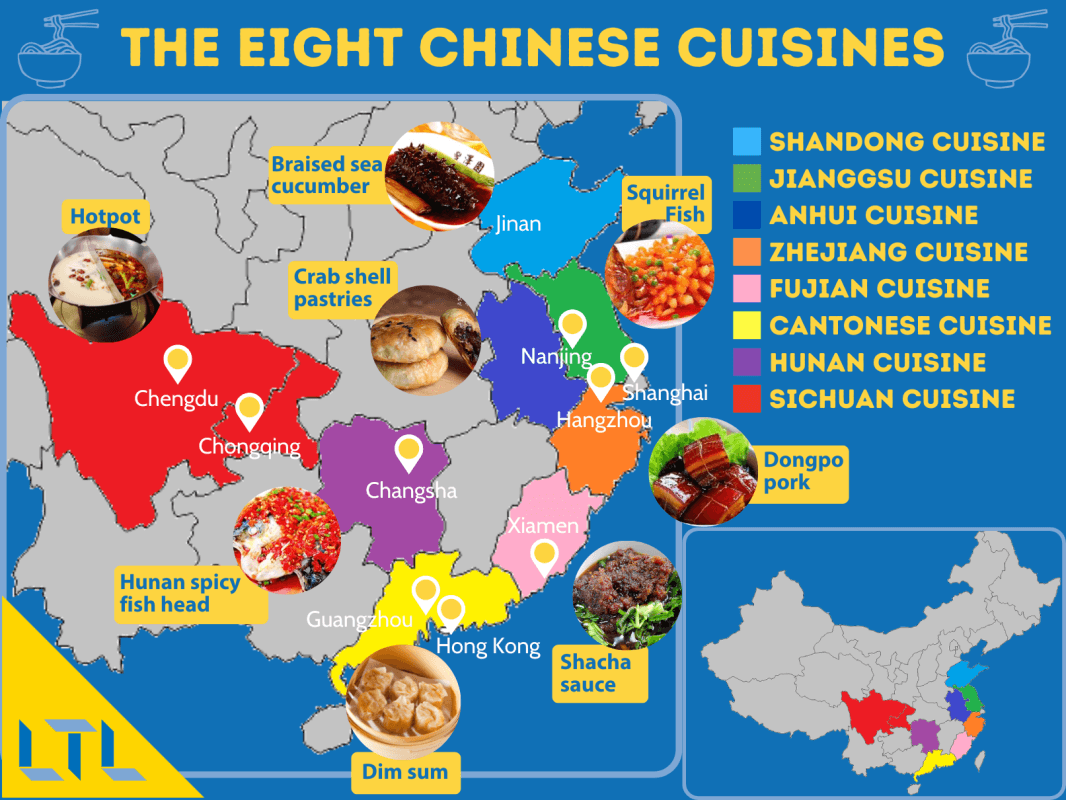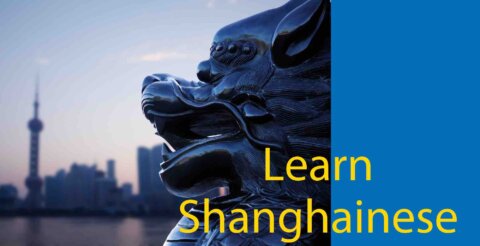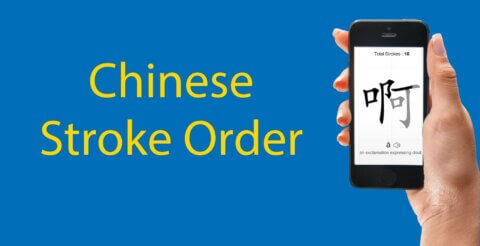North China or South China || Which is Your Favourite?
With a population of 1.4 billion people and a land area of over 9 million kilometres squared (39 times the size of the UK!), it’s hardly surprising that the country has many internal cultural, linguistic and geographical differences.

China compared to Europe by size
But despite each province having its own unique traits, one of the most common ways to differentiate between people and areas is, like anywhere, the north ( 北方 běifāng) and south ( 南方 nánfāng).
So, how different are the two regions? What are the people like? And where should you learn Chinese?
This guide explains all you need to know about the north and the south of China.
The North-South Divide
North and south China are roughly divided by the Qin Mountains and the Huai River line, with 16 provinces in the north and 15 in the south.
But since the boundary hasn’t been strictly defined, you may also hear people refer to the Yangzte River as the separation line.
Either way, it mainly refers to the cultural and geographical differences between the two regions.
Now let’s explore what they are as we break down the north and the south with the following criteria.
North vs South China | Climate
North vs South China | Landscape & Attractions
North vs South China | Cuisine
North vs South China | Culture & Stereotypes
North vs South China | Language
North vs South China | Development
North vs South China | Most Famous Cities
BONUS | The Best Place to Learn Mandarin
North vs South China | FAQs
North vs South China || Climate
The climate is one of the most noticeable differences between the north and south of China.
Generally speaking, the north has a cold and dry climate, while the south is known for its hot, tropical weather.
Like anywhere, the further north you go, the colder it gets.
DID YOU KNOW || Temperatures ( 温度 wēndù) in some of China’s northern provinces can plummet to as low as -23 °C in winter, while the southernmost cities enjoy mild temperatures of around 20 °C – even in January.
During the summer months, southern provinces experience uncomfortably hot weather, which brings with it monsoons and even typhoons.
As you might imagine, it gets very humid, with some parts of the south referred to as furnaces!
Its dry climate makes the north more pleasant during the summer, but it still gets hot!
Beijing sees temperatures of around 30°C, so yep, you’ll still need to use the air conditioning 空调 (kōngtiáo).
BONUS || Find out more about the weather in China with our monumental guide by region and month.
| North China | South China |
|---|---|
| 7/10 | 6/10 |

3 Days in Shanghai 🤔 How To Spend 72 Hours in Shanghai?
3 Days in Shanghai | 72 hours isn’t a lot of time but it’s enough to see some great things in Shanghai. Find out what to do in Shanghai in our post.
North vs South China || Landscape & Attractions
China’s diverse climate means that the landscape is extremely varied, too.
The south is more mountainous and naturally beautiful than the north.
It’s home to stunning tourist hotspots like Zhangjiajie, the karst mountains of Yangshuo (the ones on the 20 RMB note), the Yellow Mountains and the Tiger Leaping Gorge.
On the other hand, the north is better known for its culture and history.
It’s where you’ll find the country’s most famous attractions, including the Great Wall, the Terracotta Warriors and Shaolin Temple.
| North China | South China |
|---|---|
| 8/10 | 9/10 |
North vs South China || Cuisine
China’s geographical differences have also shaped eating habits in each region.
Thanks to its tropical climate, the south is the ‘rice bowl’ of China.
Farmers have been planting and farming rice since ancient times, making the grain the staple of the south.
Dishes tend to be served with rice instead of noodles, and even when they eat noodles, they’re usually made of rice! ( 米粉 mǐfěn)
ON THE CONTRARY || The north of China is more suited to farming wheat. So, noodles ( 面 miàn), steamed buns ( 馒头 mántou) and bread are the typical staples here.

Although people eat food from all over the country these days, southerners still generally prefer to eat rice with their meals, and northerners prefer noodles.
Which side are you on? We just can’t split them!
| North China | South China |
|---|---|
| 10/10 | 10/10 |
North vs South China || Culture and Stereotypes
The restaurant isn’t the only place you’ll spot cultural differences between Northerners and Southerners.
Personalities are said to differ, too – and there are plenty of regional stereotypes to show for it.
Ask anyone in China what people from the north or south are like, and you’ll likely get a similar response.
Northerners are known for being loud and tough. They like to drink, discuss politics and dream big. They’re straight-talking and laid-back – yet often stuck in their ways.
Southerners, on the other hand, are typically quieter. They’re considered soft, more materialistic and more entrepreneurial.
Unlike people from the north, they skirt around difficult conversations and use a less direct communication style.
Of course, these are just generalisations. It would be impossible to define a population of 1.4 billion people using two personality types!
But the stereotypes Chinese people have about themselves should give you a rough idea of the main regional differences.
| North China | South China |
|---|---|
| We Love Both! | We Love Both! |

How to Give Compliments in Chinese // Ultimate Guide WITH Audio
Compliments in Chinese ✨ How to Say Something Nice in Mandarin Giving compliments is a great way to connect with people, make friends, and practice your Chinese in a natural and meaningful way. Whether you’re praising someone’s appearance, skills, or…
North vs South China || Language
The good news for Mandarin learners is that the language is still the same no matter where you go.
Back in 1955, the government made 普通话 pǔtōnghuà the national spoken and written language.
Since then, it’s been the main language of instruction in schools across China, so over 80% of the population can speak and understand it.

But what about the other 20%?
They speak variations of Mandarin that most speakers of 普通话 can’t even understand.
It’s almost impossible to say how many dialects ( 方言 fāngyán) there are across China because they’re not just regional.
Different cities and even villages have their own 话 huà.
That’s why 普通话 is so important!

Now, you’re unlikely to come across anyone in a big city who can’t speak Mandarin. But if you’re travelling to remote areas, don’t be surprised if you can’t understand a thing!
When it comes to rating – we just nudge the north in front given the fact Mandarin as it is spoken today, was born in Chengde, just north of Beijing and the home of the LTL immersion program.
More on that shortly…
| North China | South China |
|---|---|
| 10/10 | 9.5/10 |
North vs South China || Development
Geographical and cultural differences aren’t all that divide north and south China.
There’s also a growing economic development gap.
Southern cities like Shanghai, Shenzhen and Hong Kong have been hubs for innovation, investment and exports since the 80s.
So, they’ve developed much quicker than most cities in the north, which are better known as the heart of politics and culture.
But the split between the north and south isn’t as shocking as the east and west.
FUN FACT || Did you know that over 94% of the Chinese population lives in just 43% of its land? Pretty crazy, right?
| North China | South China |
|---|---|
| 6/10 | 9/10 |
North vs South China || Most Famous Cities
It’s hard to fully comprehend the size of China without sitting on a 高铁 gāotiě (high-speed train), travelling at 300km per hour… for several hours.
In other words, the country is massive, and despite incredibly convenient transport links, it takes a long time to move between cities.
So, if you plan to see as much as possible on your trip to China, you’ll want to plan carefully.
Here are some of the most famous cities in each region and the attractions they’re home to.
| North China | South China |
|---|---|
| 西安 – Xi’an – Terracotta Warriors | 上海 – Shanghai – the Bund |
| 哈尔滨 – Harbin – Harbin Ice Festival | 香格里拉 – Shangri La – the Tiger Leaping Gorge |
| 平遥 – Pingyao – Pingyao Walled City | 广州 – Guangzhou – the Canton Tower |
| 济南 – Jinan – Mount Tai | 张家界 – Zhangjiajie – Zhangjiajie National Forest Park |
| 城的 – Chengde – Bishu Shanzhuang | 阳朔 – Yangshuo – the karst mountains |
| 北京 – Beijing – The Great Wall of China | 桂林 – Guilin – The “20 kuai note” |
| 郑州 – Zhengzhou – Shaolin Temple |
Which do we prefer? How can we even answer that.
Half the team love the south, half the north – in reality we all love both!
| North China | South China |
|---|---|
| We Love Both! | We Love Both! |
So, Where’s The Best Place to Learn Mandarin?
Given that Putonghua is spoken all over China, you can learn Chinese pretty much anywhere you want.
That said, if you’re looking to learn Chinese in the quickest, most immersive way, we can’t finish this article without recommending Chengde.
Free from foreign influences, this northern city is as authentic as it gets.
It’s known as being home to the most standard spoken Mandarin in the whole of China, as well as fascinating historical attractions and super friendly locals.
Of course, if you prefer a more urban experience, you can also learn Chinese in Shanghai, where modern city life and language immersion go hand in hand.
Don’t believe us… we had CCTV China come and follow our student Sean around for his experience in Chengde.
Of course, total immersion isn’t for everyone.
If you’d rather dip in and out of using Chinese, you can always consider more international cities like Beijing and Shanghai.
While it’s likely to take longer to master the language, you’re sure to have a lot of fun doing it!
| North China | South China |
|---|---|
| 10/10 | 9/10 |
BONUS || For a greater look at the best places to learn Mandarin check out this article
And there you have it!
Your guide to the differences between north and south China.
Have you visited either region before? Which of the differences surprised you most?
Drop us a comment below and tell us what you think about the north vs south China debate!
If you like this kind of content, we’ve got more you may well like too including:
- Beijing vs Shanghai | Who takes the glory?
- Hong Kong vs Singapore | Battle of Two Tiger Cities
- Disney vs Universal | Who comes out on top?

Beijing vs Shanghai (2025) // Your Comprehensive & Complete Guide
Beijing vs Shanghai — they couldn’t be more similar, and they couldn’t be more different. But which one is for you? Find out first with our in-depth guide.
North China vs South China || FAQs
How big is China?
With a population of 1.4 billion people and a land area of over 9 million kilometres squared (39 times the size of the UK!), China is one of the biggest countries in the world.
How does the climate vary in the north and south of China?
Generally speaking, the north has a cold and dry climate, while the south is known for its hot, tropical weather.
Do many Chinese live in the west of the country?
Compared to the east, no!
In fact, did you know that over 94% of the Chinese population lives in just 43% of its land? Pretty crazy, right?
Does the personality of a northerner and southern in China vary?
Generally yes! Of course this is a generalisation though so do bear that in mind.
Northerners are known for being loud and tough. They like to drink, discuss politics and dream big. They’re straight-talking and laid-back – yet often stuck in their ways.
Southerners, on the other hand, are typically quieter. They’re considered soft, more materialistic and more entrepreneurial.
What is the staple dish for north China and south China?
Thanks to its tropical climate, the south is the ‘rice bowl’ of China.
Farmers have been planting and farming rice since ancient times, making the grain the staple of the south.
Dishes tend to be served with rice instead of noodles, and even when they eat noodles, they’re usually made of rice! (米粉 mǐfěn)
ON THE CONTRARY || The north of China is more suited to farming wheat. So, noodles (面 miàn), steamed buns (馒头 mántou) and bread are the typical staples here.
Where is the best place to learn Mandarin?
If you’re looking to learn Chinese in the quickest, most immersive way, there is no doubt our favourite place is Chengde.
Free from foreign influences, this northern city is as authentic as it gets.
It’s known as being home to the most standard spoken Mandarin in the whole of China, as well as fascinating historical attractions and super friendly locals.
Want more from LTL?
If you wish to hear more from LTL Mandarin School why not join our mailing list.
We give plenty of handy information on learning Chinese, useful apps to learn the language and everything going on at our LTL schools!
Sign up below and become part of our ever-growing community!
BONUS | Want to study the local dialect known as Shanghainese? We provide Shanghainese Classes in person and online.
⭐ Download our free ebook, your starter pack of essential Mandarin learning resources!


 Hi, my name is Mojca. I am from Slovenia in Europe and I and I work as a student advisor at our Shanghai school.
Hi, my name is Mojca. I am from Slovenia in Europe and I and I work as a student advisor at our Shanghai school.







1 comments
[…] FUN FACT #32: https://ltl-shanghai.com/north-vs-south-china/ […]